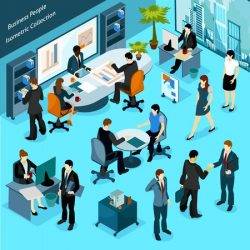October 12, 2017
Working conditions and office design shown to impact on employee performance

New evidence of a strong correlation between productivity, creativity and even profitability with employee working conditions, such as: light, air, noise, health, culture, design, movement and the quality of furniture have been established in a new report. The syndicated research project, Wellness Together, carried out by Sapio Research, of 1000 UK based office workers and 50 Facilities Management experts, suggests a strong link between people feeling catered and cared for by their workplace/employers and how this impacts business performance. Wellness at work is a dominant theme in any discussion about the workplace. But this is not just a discussion about happiness, it is about creating cultures and environments that are conducive to commercial success. The study identifies that in order to achieve true ‘Wellness’ attention to every single component that can impact mental and physical health needs to be considered, from building structures and company cultures through to the physical furniture and fittings that employees require to work efficiently and effectively.
Crucially, there isn’t a quick fix to ensuring Wellness at Work, it is the right combinations of many factors that will be unique to every organisation that make the difference.
The key findings of the project, which was commissioned by leading companies in these specialist sectors: BDG architecture + design, Bisley, FUTURE Designs, Hoare Lea, Humanscale and Woven Image include:
Workplace conditions drive Profitability, productivity and innovation
The study showed that companies which have good environmental conditions at their workplace and have supportive/flexible working practices are more productive, innovative and profitable.
Highly profitable companies are more likely to have staff that say they have better physical and mental wellbeing. (Employees with a high sense of mental wellbeing work in companies that have an average gross profit margin that is 3% higher than companies with average/ neutral self-rated wellbeing and 7% higher than those where employees rate themselves as mentally unfit). For physcailly fit individuals their employers reap an averge gross profit margin of 8% more than those with physically unfit staff.
Higher profitability is also associated with companies that have greater agility and flexible working practices. (companies with a high level of flexibility and agility have 6% higher gross profit margins, on average, than companies with low flexibility and agility)
Companies that demonstrate greater innovation and creativity are also more profitable with the highly innovative organisations having 8% more average gross profit than their less innovative counterparts.
Higher performing companies are more likely to have a wide range of facilities in place for their staff and include features that promote wellbeing such as showers, cycle parking, personal lockers, plants, quiet working spaces, variable lighting control, workstations that promote healthy posture and amenities for social.
Employees in high performance companies say they have more freedom to choose how they work and move about. (e.g. move to another space in the office, choose between sitting and standing, have some healthy food or go home to finish work).
Only 53% of employees feel they have adequate control over their comfort when working though. Companies that give employees’ confidence that they can influence their own conditions are more profitable, having an average gross profit of 3% more those without employee confidence.
Those working in more senior roles are more sensitive to distractions and also more reactive to improvements in their environment. The same is true for those who work at different sites or locations most days.
Workplace Design
Workplace design has an impact on staff retention – 48% think that the workplace design has a notable impact on their decision as to whether to stay with an employer. A similar proportion are currently looking for a new job or likely to be in the next 18 months.
There isn’t one style of working that fits everyone or applies all of the time. According to the survey, working flexibly is about having variety in how and where you work; whether it’s the ability to work from home or outside the workplace sometimes, or having an office layout that offers a variety of spaces and configurations.
The importance of flexibility can also apply to posture. A quarter of people say they would like the option of being able to stand or sit when they work.
In terms of priorities, the desire for a personal, comfortable space is high. Half of the people surveyed said that having their own desk is important. Conversely, it also shows that for half of the employees it isn’t a particularly important requirement.
People think it’s important to have breakout and collaborative spaces (27%) and the opportunity to find a quiet private space (43%) when they need it.
Environmental conditions in the workplace
Offices should be designed to avoid hot and stuffy conditions and to have natural daylight to improve productivity and avoid dips in concentration.
Better ventilation is the number one environmental improvement factor identified in the workplace. Other important elements are the ability to control temperature, have more natural light and the ability to open windows are also important for employees.
Healthy workplace
Having healthy food at the office (e.g. fresh fruit) and access to outdoor space are key priorities for an improved workplace environment.
Some common distractions that bother people are related to office management and behaviours, such as messy desks (28%) and shared spaces (34%), hunting for stationery (21%), smelly sports kit (28%) in the office or people nearby being loud (25%). These distractions could be resolved by implementing better facilities and policies.
Employees that rate themselves as having low physical and mental wellbeing typically feel less able to do the things that are good for their concentration and productivity, such as being able to move around, vary their task or eat healthy food. Conversely, employees that feel physically and mentally fit tend to work in healthier and more flexible environments.
Staff engagement is important. Generally, employees with low physical and mental wellbeing work in companies with inflexible working practices, with fewer digital collaborative tools and lower levels of staff consultation.
Jane Hales, Managing Partner of Sapio Research said: “Given the apparent inverse relationship between productivity and absenteeism currently in the UK, it’s no surprise that over half (55%) of employees recognise there is a problem with their own company’s productivity. Of course, there is no single quick fix to this but it’s great to be able to identify a number of key facilities and behaviours that companies can change to overcome the challenge, many of which are often very low cost.
The presenteeism phenomena of staff working while unwell is costing the UK twice as much as absenteeism, so it’s in everyone’s interest to stimulate greater engagement among the most vital resource; employees.”












